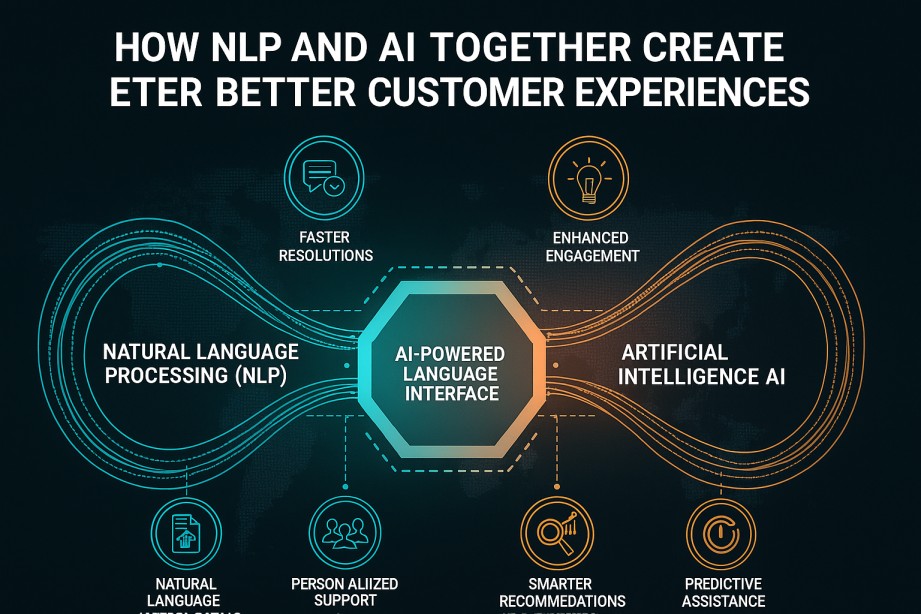Introduction
In an era where customer experience defines business success, Artificial Intelligence (AI) and Natural Language Processing (NLP) have become the backbone of intelligent interactions. Today, customers expect instant, personalized, and empathetic communication — something traditional systems often fail to deliver.
According to Salesforce, 88% of customers say the experience a company provides is as important as its products or services. This is where AI and NLP come together — transforming data-driven insights into human-like understanding to create smarter, faster, and more engaging customer experiences.
Understanding NLP and Its Role in AI
Natural Language Processing (NLP) is a branch of AI that helps machines understand, interpret, and naturally respond to human language. It powers the technology behind chatbots, sentiment analysis, speech recognition, and personalized recommendations.
AI, when combined with NLP, doesn’t just analyze data — it comprehends context, tone, and emotion, enabling brands to communicate in ways that feel authentically human.
| AI + NLP Application | Customer Impact | Business Value |
| AI Chatbots with NLP | 24/7 instant support in natural language | Reduces support costs by up to 30% |
| Sentiment Analysis Tools | Understand customer emotions in real time | Helps brands respond with empathy |
| Voice Assistants (e.g., Alexa) | Enables voice-driven interactions | Enhances accessibility and convenience |
| Predictive Recommendations | Personalized content and offers | Boosts conversion and customer retention |
How AI and NLP Transform Customer Experience
1. Hyper-Personalized Communication
AI-driven NLP models analyze millions of customer interactions — from emails to chats — to tailor responses that resonate with individual needs.
For instance, Netflix uses AI and NLP algorithms to recommend content based on a user’s viewing history, tone, and preferences, leading to a 75% increase in engagement through personalized recommendations.
2. Real-Time Sentiment Analysis
With NLP, AI systems can gauge customer emotions — positive, negative, or neutral — in real time. This allows companies to respond proactively. For example, if a customer expresses frustration, the system can escalate the issue to a human agent before dissatisfaction grows.
3. Conversational AI for Instant Support
Chatbots powered by NLP can resolve 70-80% of common customer queries without human intervention. They understand natural speech patterns, slang, and intent — creating fluid, human-like interactions that improve satisfaction rates and reduce response times dramatically.
4. Voice-Enabled Customer Assistance
Voice-based AI tools like Google Assistant and Siri demonstrate how NLP allows customers to engage without typing. In customer service, voice AI reduces call times and increases accessibility, creating frictionless support experiences for users across demographics.
5. Predictive Insights for Continuous Improvement
AI-powered NLP analyzes unstructured data — such as reviews, social media comments, and feedback — to uncover hidden trends. Businesses use these insights to improve products, refine messaging, and anticipate future needs, driving continuous improvement in CX strategy.
The Human Element in AI-Powered Customer Experience
While AI and NLP automate interactions, the human touch remains crucial. The future isn’t just about replacing human agents — it’s about empowering them.
AI provides customer history, preferences, and emotional tone before a conversation even begins. This helps agents respond more empathetically and resolve issues faster. The result is a balance between automation and authenticity — where customers feel understood, not processed.
Challenges and Considerations
| Challenge | Description | Solution |
| Data Privacy | Ensuring AI doesn’t misuse sensitive information | Adhering to GDPR and ethical AI frameworks |
| Language Diversity | Handling multiple languages and dialects | Multilingual NLP models (like GPT or BERT) |
| Emotional Intelligence in AI | Detecting sarcasm, humor, and empathy | Continuous AI model training with real-world data |
| Human Oversight | Avoiding over-reliance on automation | Hybrid models combining AI and human judgment |
The Future of AI and NLP in Customer Experience
By 2030, AI-driven customer interactions are expected to account for 95% of all customer service engagements. NLP will evolve to not only understand words but also interpret emotions, intent, and cultural nuances.
The next generation of AI-driven CX will feature:
- Emotionally intelligent AI that adapts its tone based on user sentiment
- Multilingual, context-aware virtual assistants capable of nuanced responses
- Predictive empathy, where AI anticipates customer needs before they express them
Organizations investing in AI + NLP now will stay ahead — creating experiences that are not just efficient, but truly human.
Conclusion
The synergy of AI and NLP is redefining customer engagement by bridging the gap between data and emotion. Businesses that embrace this transformation will deliver personalized, predictive, and emotionally intelligent experiences that foster loyalty and trust.
In the digital era, customers don’t just want quick answers — they want to be understood. With AI and NLP working together, that understanding is no longer a future goal — it’s happening today.







